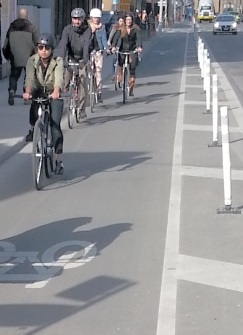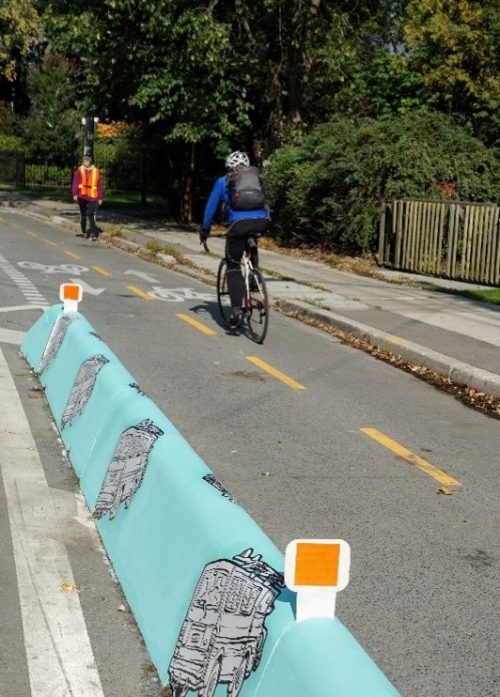
In 2020 and 2021, the City extended cycle tracks on Bloor Street west from Shaw Street to Runnymede Road to improve safety for people cycling, and provide connections to existing and proposed north/south cycling routes on Shaw Street, Runnymede Road and the West Toronto Railpath. The protected bike lanes create a dedicated space for people cycling and improve safety for all road users.
The City has created an infographic PDF for people who access Bloor Street West for a range of different needs, which explains how best to interact with the newly installed infrastructure.
While we aim to provide fully accessible content, there is no text alternative available for some of the content on this page. If you require alternate formats or need assistance understanding our maps, drawings, or any other content, please contact us at cycling@toronto.ca.
Cycling, pedestrian and motor vehicle counts were collected between 2016-2018 (before installation) and 2021-2022 (after installation) at six intersections along Bloor Street West. A review of before-and-after data along the
extension limits found that, following the installation of cycle tracks, generally the volume of people cycling has increased, while the volumes of people driving and pedestrians have decreased. More details about the data review can be found in the Bloor Street West - Shaw Street to Runnymede Road infographic.
City Council, at its meeting on May 28, 2020, approved the extension of the Bloor Street West Bikeway.
Please convey any maintenance requests through 311.
The project area stretches on Bloor Street West from Shaw Street to Runnymede Road. It connects to the existing bikeway on Bloor Street West, which runs from Avenue Road to Shaw Street.

In 2016, the City implemented the first pilot project to install and evaluate cycle tracks on Bloor Street West between Shaw Street and Avenue Road. Since then, it has become the second busiest in the city with approximately 5,220 daily users. On average, 13% of people living in the project area cycle to work or school. In some areas, this number is as high as 29%.
Based on the results of the 2016 pilot project in fall 2019, City Council directed City staff to begin the design and consultation of extending bikeways on Bloor Street West from Shaw Street to High Park.
City staff utilized the learnings from the 2016 pilot project to inform the western extension. The following is a timeline of events that took place prior to the 2020 installation:
| Phase | Progress | Events |
| Fall 2019 |
|
Businesses and Organizations Drop-In Events
|
| Winter 2020 |
Public Consultation
|
Public Drop-In Events
|
| Spring 2020 | Report to Infrastructure & Environment Committee and City Council | |
| Summer 2020 | Installation |
The goal of this project was to create a safe, multi-modal and vibrant Bloor Street West by:


The design included:
In-depth data analysis was used to inform the design process, including:
Bike facilities are designed to support safe and accessible use. The Project Team consulted with City staff and agencies including TTC, Emergency Services and traffic engineering.
The design of the bike facilities was informed through consultation and feedback received from local stakeholders and community groups, residents, and businesses, data analysis, and review of technical information.
The bike facilities are designed to maintain safe building access for people arriving on foot, bike, transit and by car.
City staff conducts multiple counts to assess on-street parking demand during the busiest times of the week. This was done on a block-by-block basis. Available off-street parking is also considered.
The City addressed existing loading and delivery needs through consultation with businesses, organizations and building owners on Bloor Street. In the existing Bloor Bikeway, businesses’ loading needs are accommodated using mostly side streets and back alleys. Some have had to modify their loading process.
TTC Wheel-Trans vehicles and accessible taxis are allowed to load passengers in the bikeway. In addition, on-street accessible parking and loading spaces are being investigated in the design where feasible.
Bikeways provide safe options for people who want to bike to school or work, for shopping, recreation and other trips.
An important purpose of adding bikeways is to improve safety for people of all ages and abilities, including people who walk, take transit, ride a bike or drive a car. Studies in Toronto and elsewhere have shown that adding bikeways improves safety for all road users. By adding bikeways and reducing traffic lane widths, motorists tend to slow down. Slower speeds reduce the number of collisions, and their severity if they do occur.
The extension was designed to provide separation for people cycling from cars. Driving, parking and stopping of motorized vehicles are prohibited in bike lanes and cycle tracks. In most locations, the bike lanes were separated from vehicles using a physical barrier, such as plastic flexi-posts, concrete curbs, planter boxes, or some combination of the above.
After installation, the City continues to:
After monitoring and evaluating, the City will consider modification, such as:
More detailed information on the project design can be found on the Public Drop-In Event's information panels.
After opening the files below, zoom in to view the details.
The public comment period was open from January 24 to February 14, 2020.
View the Consultation Report for more information.
The City hosted two public drop-in events on January 27, 2020, at St. Wenceslaus Church and January 30, 2020, at the Lithuanian House.
At the events, attendees were able to view the information panels in print and discuss one-on-one with the project team. The same information was available at both events.
Those who were unable to attend either event were invited to submit an online feedback form between January 24 and February 14, 2020.
The City hosted four drop-in events in the project area for building owners, business owners and organizations in each of the Business Improvement Areas (BIAs) on Bloor Street West in the project area.
Drop-In events were held at:
At the drop-in events, building owners and representatives of businesses and organizations in the project area on Bloor Street West had an opportunity to:
Those who were unable to attend either event were invited to review the consultation material before filling out businesses and organizations stakeholder survey. The survey closed on December 9, 2019.